
IF YOU THINK American politics have become nasty and "uncivil,"
try the history of the American West. You can be called a liar,
a thief and anything from a draft-dodging coward to a sexual pervert
just for expressing an opinion about who shot notorious badass
Johnny Ringo. There are people who take this stuff as seriously
as the Earps and Clantons took each other. They can make a Jesse
Helms speech on the U.N. sound equivocating and a Leno monologue
on Clinton seem downright benevolent.
 Much of the controversy revolves around that somewhat enigmatic
figure, Wyatt Earp. You get a whiff of just how intense that controversy
is by attending a conference--the "Annual Rendezvous"--of
a group of western history buffs called the National Outlaws and
Lawmen's Association (NOLA). They met recently in Tucson, and
Earp was high on their agenda.
Much of the controversy revolves around that somewhat enigmatic
figure, Wyatt Earp. You get a whiff of just how intense that controversy
is by attending a conference--the "Annual Rendezvous"--of
a group of western history buffs called the National Outlaws and
Lawmen's Association (NOLA). They met recently in Tucson, and
Earp was high on their agenda.
Almost 200 people from around the country spent four days here
and in Tombstone listening to a variety of speakers and writers
discussing Doc Holliday, Earp, and some lesser-known bad and good
guys, while another 50 or so exhibitors, authors and booksellers
set up at the back of the meeting room at The Holiday Inn Palo
Verde.
The conference itself was generally polite. The membership
consists mainly of normal folks--unlike Trekkies, there were few
bizarre costumes--and the organization's leadership tried to keep
the verbal bloodshed to a minimum. But most of the principle antagonists
showed up on the first morning, and you needed one of the Bowie
knives on display to cut the tension. Some of these people really
don't like each other.
While their arguments occassionally degenerate into personal
attacks, they're often substantive and reflect deep differences
in everything from methodology to cultural heritage. There's also
a decided conflict between those who publish books and articles
and those who don't. Some of the non-published prefer spending
their time attacking those who do.
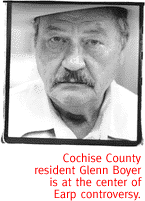 The central figure of the Earp controversy is longtime Cochise
County resident Glenn G. Boyer. Love him or hate him--and there's
little middle ground--he's as central a figure to Earpiana (the
term he coined) as Earp himself was to Tombstone. He's been
vilified and praised, plagiarized and quoted by almost everybody
who ever studied the subject. He's been called a liar, a fraud,
a perpetrator of hoaxes and worse. There's even a current hit
sheet circulating accusing Boyer, a retired lieutenant colonel
and command pilot who spent 20 years in the U.S. Air Force, of
being a draft dodger who manipulated his entire military career
to avoid combat. Like an old western-movie fast-gun hero, Boyer
has plenty of enemies who want to take him on. And unlike the
challengers in most of those old flicks, many of Boyer's enemies
aren't above back-shooting.
The central figure of the Earp controversy is longtime Cochise
County resident Glenn G. Boyer. Love him or hate him--and there's
little middle ground--he's as central a figure to Earpiana (the
term he coined) as Earp himself was to Tombstone. He's been
vilified and praised, plagiarized and quoted by almost everybody
who ever studied the subject. He's been called a liar, a fraud,
a perpetrator of hoaxes and worse. There's even a current hit
sheet circulating accusing Boyer, a retired lieutenant colonel
and command pilot who spent 20 years in the U.S. Air Force, of
being a draft dodger who manipulated his entire military career
to avoid combat. Like an old western-movie fast-gun hero, Boyer
has plenty of enemies who want to take him on. And unlike the
challengers in most of those old flicks, many of Boyer's enemies
aren't above back-shooting.
Boyer's most recent principle antagonist is Casey Tefertiller,
author of Wyatt Earp--The Life Behind the Legend (Wiley
& Sons, 1997). Unlike most of Boyer's detractors, Tefertiller
at least actually wrote a book, although Boyer alleges it's really
a committee product. Tefertiller himself lends credence to that
charge by often lapsing into "we" when discussing it,
and referring questions about it to others during Q&A sessions.
Tefertiller is vitriolic in his attacks on Boyer. At a January
conference of another group of western history buffs, the Western
Outlaws and Lawman's Association (WOLA--not to be confused with
NOLA), he likened Boyer's work to that of holocaust revisionist
writer David Irving. Yet one of his own footnotes quotes a Boyer
article on Morgan Earp.
Tefertiller and the anti-Boyer crowd went bonkers when they discovered
Boyer had canceled his appearance in what was being billed as
the big shootout over the OK Corral. Boyer begged off, saying
he was suffering from the flu. His antagonists immediately claimed
Boyer was a coward afraid to face their champion Tefertiller and
spent the remainder of the weekend loudly trashing him.
Tefertiller, claiming prior commitments, recently turned down
an opportunity to debate Boyer live or by telephone hookup on
local radio immediately following the NOLA gathering--an offer
Boyer accepted. No one has accused Tefertiller of cowardice for
that, and Boyer's critics should give him the same courtesy over
his January illness. Too bad the shootout didn't come off--Tucson
Media Monitoring would've made a bundle from Earp buffs on that
exchange.
EARP MYTHS HAVE been bouncing around almost since the shootout
at the OK Corral. Then as now, there were partisans of both sides
of his character. But the whole thing really took off with the
1931 publication of Stuart Lake's 1931 classic Wyatt Earp--Frontier
Marshall, a stylized gloss that almost made Earp into a plaster
saint. Although well-written and still in print, the book dodges
many facts. Nevertheless, it was how most came to learn of Earp
and the Tombstone saga for years. It's the foundation of many
of the earlier movie portrayals.
Lake was one of several writers who worked with Earp, who died
in 1929. It's generally suspected that Lake's publishers, hoping
for a big-seller, may have guided many of his inaccuracies. Others
tried to get another book out of Earp's widow, Josie, who lived
until 1944, but according to some family members she was manipulative
and wanted certain things that would've reduced her "respectability"
left out--like Earp's second wife, to whom he was married when
Josie ran off with him.
The debunkings began in 1960 with Frank Waters' now-discredited
The Earp Brothers of Tombstone, which portrayed them as
little more than thugs. Others, including Boyer, have contributed
to the rather large Earp bibliography over the years. Boyer believes
Waters' malice was motivated by a desire to get even with Josie
for failing to give him her story. Boyer alleges Waters falsified
statements of Virgil Earp's widow, Alvira (Allie). Virgil died
in 1905, his widow lived until 1947.
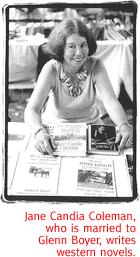 Tefertiller's book--published by a large New York outfit noted
for producing architectural material, not Western American history--came
out last year. It was accompanied by a strange publicity sheet--strange
because a quarter of it was devoted to an attack on Boyer. Yet
except for one footnote, Tefertiller's book didn't mention Boyer.
If someone were writing a psychiatric treatise attempting to debunk
Freud, we'd expect at least a mention of Freud in the text.
Tefertiller's book--published by a large New York outfit noted
for producing architectural material, not Western American history--came
out last year. It was accompanied by a strange publicity sheet--strange
because a quarter of it was devoted to an attack on Boyer. Yet
except for one footnote, Tefertiller's book didn't mention Boyer.
If someone were writing a psychiatric treatise attempting to debunk
Freud, we'd expect at least a mention of Freud in the text.
Tefertiller greatly enhanced the Earpomania debate by his almost
unprecedented attacks on Boyer, not that Boyer hasn't had his
detractors over time. That's easy to understand--Boyer is opinionated,
cantankerous, interesting and funny as hell. And he's not kind
to his detractors, giving them back at least as good as
he gets. But when one historian goes after another, it's fair
to judge the attacker by the quality of his own work, and in this
regard, Tefertiller doesn't measure up.
Tefertiller claims that while Earp was hanging around Hollywood
backlots at the end of his life, he ran into the young Marion
Morrison, a.k.a. John Wayne, who later "modeled his persona"
on those encounters. Tefertiller's source? A single remark by
TV's Wyatt Earp, Hugh O'Brian, claiming that the Duke once,
30 years ago or so, told him that he was doing a helluva job,
and he, the Duke, should know because he knew Wyatt Earp. That's
it. No other reference, no other source, no mention of this rather
earth-shaking news by anybody who ever knew John Wayne, including
John Ford, who did know Earp and who undoubtedly would've told
everyone if Earp had met Wayne.
Or, as Tefertiller said of a claim of Boyer's at the NOLA gathering:
"A story he heard from somebody else with no substantiation."
IT'S DIFFICULT TO take Tefertiller as the "definitive"
Earp biographer when he fails even to mention Earp's sister, Adelia.
(There were two more Earp brothers missing at the famous street
fight in Tombstone, James and Warren, but they had other roles
in the Tombstone saga.) The Tucson Weekly's review of Terfertiller's
book was titled "Earp, Slop, Get the Mop" (December
10, 1997). Tefertiller wrote demanding another review from someone
friendlier, along with a long whining phone call. He just couldn't
grasp why the reviewer thought his efforts were inadequate, and
he simply continued stating that Boyer was "discredited."
He declined an invitation to write a letter to the editor.
One who did write was Earp buff Roger Peterson, who sent a letter
much too long to print defending Tefertiller as "a trained
journalist." Peterson spoke on Earp at the NOLA convention,
leading off with the statement that Earp has only had "two
real biographers"--Lake and Tefertiller. Otherwise, he underscored
the obvious.
Peterson is the kind of guy who would give you a lecture on jungle
lore that told you lions bite, fire burns, and it rains a lot.
He also decried the "turf wars" taking place in western
history--odd, because he's one of the most partisan of the turf
grabbers. That is, if he ever published anything of note on the
Earps, which he hasn't. He also dislikes Boyer's writing style,
which many find engrossingly superior to his, or Tefertiller's.
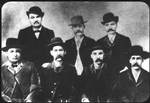 Tefertiller also claims that family members are generally "unreliable"
as historical sources. Boyer's 50-plus years of research into
the Earp legend involves massive materials gleaned from Earp family
members and others to which Tefertiller didn't have access. One
can clearly understand Boyer's choice of methodology.
Tefertiller also claims that family members are generally "unreliable"
as historical sources. Boyer's 50-plus years of research into
the Earp legend involves massive materials gleaned from Earp family
members and others to which Tefertiller didn't have access. One
can clearly understand Boyer's choice of methodology.
Those who promote Tefertiller's work by stressing he's a "trained
journalist" have brought their ducks to the wrong market.
Today's "trained journalists" are taught to rely heavily
on two things--official sources and prior news stories. Thus Tefertiller's
bibliography neglects many secondary sources.
He claims that many of those secondary sources aren't all that
relevant, but that causes him real credibility problems. For example,
Tefertiller waxed on at the NOLA gathering about his "discovery"
of the resignations of Wyatt and Virgil Earp as lawmen in 1882.
As Terfertiller was speaking, however, Tombstone town historian
Ben Traywick walked over and silently handed a reporter a copy
of Tombstone Clippings, edited by Traywick and published
in 1989. It contains a copy of that resignation on page 174.
SO MUCH FOR the unworthy challenger. What about the man
who calls himself "The Icon"? Wisconsin-born, 74-year-old
Glenn Boyer is a very difficult man for some to understand. He
autographed a pamphlet to a reporter as follows: "For my
old dissolute, delightful, distant acquaintance Whatsis--Glenn."
Not the kind of guy who kisses your ass even when he knows you
plan to write about him.
Except for his passion to keep what he considers to be the truth
about the Earp legend straight--a promise he made to a close friend,
Earp's niece Estelle Miller--the most telling fact about Glenn
Boyer is that he often just doesn't give a damn. He has a sense
of humor, unlike Tefertiller and most of his adherents, who appear
dour, boring, and constantly uptight. They don't even know when
they're being tweaked.
Boyer has written more about the Earps and the other western
characters who revolved around them than anyone, and over the
last half-century he's revised some of his own material. His first
book, An Illustrated History of Doc Holliday, was an admitted
hoax at the time of publication in 1966--something ignored by
his detractors, who keep accusing him of doing what he admitted
all along. Boyer says he did that--and has done it elsewhere--to
illustrate how easy it is to bullshit people over the history
of the Old West, and to make people wary of much of what has been
written.
This led to his first major work, The Suppressed Murder of
Wyatt Earp (Naylor, 1967, reprint editions available from
the author). Boyer chose that title to illustrate how the Earp
myth then being perpetrated was murdering the memory of the real
man.
Two of his other major books are I Married Wyatt Earp
(University of Arizona Press, 1976, still available in paperback)
and Wyatt Earp's Tombstone Vendetta (Talei Publisher's,
Honolulu, 1993, available most easily from the author at P.O.
Box 40, Rodeo, New Mexico, 88056).
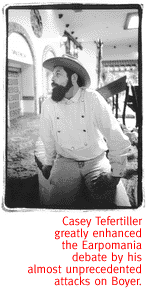 Both these titles are clearly described as "Collected and
Edited by Glenn G. Boyer," a description which points to
the crux of the controversy over his works: Academic historians
dislike Boyer's method, and his enemies claim the manuscripts
and other items he has based these and other works on may not
even exist.
Both these titles are clearly described as "Collected and
Edited by Glenn G. Boyer," a description which points to
the crux of the controversy over his works: Academic historians
dislike Boyer's method, and his enemies claim the manuscripts
and other items he has based these and other works on may not
even exist.
Boyer says he's tried to imitate the novelist-approach-to-history
popularized by Truman Capote with In Cold Blood. Boyer,
too, is a novelist. He published a group of books in the 1980s.
His latest, Winchester Affidavit (Thorndike Press, 1997),
is set in New Mexico and fictionalizes late 19th-century events
there. His wife, Jane Candia Coleman, has also used this form
successfully in Doc Holliday's Woman (Warner Books, 1995)
and her latest book, I, Pearl Hart (also published by Thorndike).
Interestingly, no one of note has yet to attack Coleman, who uses
the same method and often the same research base.
Advocates of various standards of recording history are driven
nuts by Boyer's methods. He edits primary sources and uses composite
characters speaking in the first person, often without direct
attribution. I Married Wyatt Earp is based on multiple
sources, including two attempts by Earp's widow Josephine to tell
her story her way. That she wanted both herself and Wyatt to look
"respectable" shouldn't be surprising. That she also
told relatives things not included in what she told several ghost
writers would also logically follow.
Boyer used the same novelistic approach in Wyatt Earp's Tombstone
Vendetta, employing fictional characters he names Ten Eyck
and Ten Eyck Jr. to relay many things not presented elsewhere--
from the death of Johnny Ringo to that of Old Man Clanton. Boyer
alleges Wyatt Earp killed both of them, a claim which is hotly
disputed by many others, including Ringo's biographer, Jack Burrows
(Johnny Ringo; The Gunfighter Who Never Was, UA Press,
1987).
Boyer's critics are now all over him for inventing Ten Eyck,
and they're once again claiming "fraud." But a cursory
glance at Vendetta makes it obvious Ten Eyck is a composite
character and that Boyer's reason for using him is to cover sources
he feels obligated to protect and privacies he wishes to honor.
BOYER'S CONNECTIONS TO the Earp family and other first-hand
sources who knew Wyatt and his brothers are easily documented--when
he feels like showing this stuff to you, as he did recently to
a reporter. He was close to many Earp relatives and descendants,
including Estelle Miller, Adelia's daughter, and her husband Charles,
who provided him with much material. This is the same Adelia Earp
ignored in Tefertiller's "definitive" biography.
Relatives of historical figures, particularly controversial ones,
usually don't like being readily available to anyone who wants
to talk to them or poke through their stuff. Many wish to keep
their privacy; others don't want to be quoted for fear of offending
other family members; still others want secrets to remain so until
they pass on. Journalists call these people "sources"
and protect them.
Which is where Boyer's methods also conflict with Tefertiller's.
Boyer uses those sources; Tefertiller usually sticks to standard
practice and refuses to count many of them, although his choices
often seem arbitrary. As a result Boyer's occasional highly-educated
guesses appear to be as useful as Tefertiller's research, or anybody
else's.
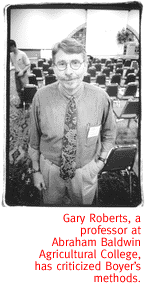 Of course, Boyer's methods don't sit well with the academic types,
who are trying to move western history away from the "buffs"
and stratify it according to "accepted methods of historiography."
Of course, Boyer's methods don't sit well with the academic types,
who are trying to move western history away from the "buffs"
and stratify it according to "accepted methods of historiography."
One academic who went after Boyer is Prof. Gary Roberts of Abraham
Baldwin Agricultural College in Tifton, Georgia. In a long article
in a recent western-history newsletter, reprinted in The Tombstone
Tumbleweed, Roberts lashed out at Boyer for a number of sins.
These include a belief that historians "demand the highest
standards of research and historical method," that "reminiscences
are not the most credible historical documents," and most
telling from Roberts' perspective: "Original discovery does
not convey an exclusive right to interpret, or guarantee that
the researcher who makes the find will necessarily provide the
'best' explanation of its meaning."
Roberts also wrote a jacket blurb for Tefertiller's book, apparently
indicating the reminiscences of Hugh O'Brian are acceptable to
him.
One of Roberts' real problems with Boyer is that he hasn't shared
much of his research. Boyer pleads guilty to that charge, admitting
he doesn't share with people who piss him off. Boyer's attitude:
If you want to know about this stuff, go look like he did. Roberts
treats Boyer like a teaching assistant who's obligated to turn
over what he finds, and bitches when he won't.
But Boyer has shared with others, including Roberts, who says
of him, "Until Boyer's sources can be authenticated, the
interpretations based on them cannot even be addressed."
But this year's publication by the University of Oklahoma Press
(a publisher well-respected for its western history titles) of
Karen Holliday-Tanner's Doc Holliday: A Family Portrait
was disconcerting for both Roberts and Tefertiller. Tefertiller
even refused to participate in a joint book-signing at a local
bookstore with her.
Tanner is the great-granddaughter of Doc Holliday's cousin, and
had access to items never before presented. She gives credit to
her husband John Tanner, a history professor at Palomar College,
for his assistance, which should satisfy the academics. And she
strongly credits Boyer for his aid in allowing her access to all
those documents and items that some keep claiming don't exist.
Tanner now joins the ranks of Ben Traywick and others who thank
Boyer for his help, as does by implication Bat Masterson's biographer
Robert deArment (Bat Masterson: The Man and the Legend,
University of Oklahoma Press, 1979), who wrote the introduction
to Tanner's book. Tefertiller's almost mantra-like claims that
Boyer "has been discredited" have fallen on their ass.
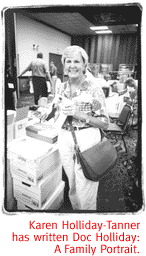 Roberts, who's been working on a biography of his fellow Georgian
Doc Holliday for some time, is the author of more than 50 articles
on western lore and several books on violence in the Old West.
His latest is Death Comes to the Chief Justice (Slough-Rynerson,
1990), about events in early New Mexico. He recently visited Boyer's
ranch, and now concedes that Boyer does have "much"
of what he claims, but still disputes his methodology.
Roberts, who's been working on a biography of his fellow Georgian
Doc Holliday for some time, is the author of more than 50 articles
on western lore and several books on violence in the Old West.
His latest is Death Comes to the Chief Justice (Slough-Rynerson,
1990), about events in early New Mexico. He recently visited Boyer's
ranch, and now concedes that Boyer does have "much"
of what he claims, but still disputes his methodology.
"Historians should not put words in the mouths of the dead,"
Roberts says.
Novelists do, and Boyer's response is, "I'm a novelist--and
a damn good one."
MEANWHILE, HOLLIDAY MAY replace Wyatt Earp as the biggest
storm of controversy for western buffs. Roberts already disputes
some of Tanner's contentions--again, we're back to who shot Johnny
Ringo. Tanner agrees with Boyer that it was probably Wyatt, with
Holliday along for the ride.
Roberts sides with Tefertiller, who simply dismisses it as "highly
unlikely" and refuses to discuss credible evidence supporting
Boyer's contention. But Roberts says he respects Tanner's work,
although he'll reserve comment on much of it until he's had time
to review it. And he decries the personal animosity that has set
into the Earpiana debate, placing some distance between himself
and Tefertiller's "David Irving" charges against Boyer.
While it's clear that some Earpomaniacs have considerably less
integrity than the bad-asses they discuss, most are normal people
with a deep interest in a fascinating subject. It's impossible
to write a full history of Arizona and the West without discussing
the events in Tombstone in the 1880s. Who killed Johnny Ringo
will be debated at least as long as who killed Napoleon or Hitler.
After all the pulling and tugging and name-calling, it's clear
that the real picture of Wyatt Earp has emerged. While not exactly
Stuart Lake's Boy Scout, he was hardly a thug. In the confines
of his times, he was a reasonably decent man, a real leader, and
tougher than hell when he had to be. Even the newer flicks like
Tombstone and Kevin Costner's Wyatt Earp are much
closer to reality than earlier attempts.
That this view is now generally considered accurate by most Earpomaniacs
can be attributed to one man--Glenn Boyer. It was Boyer who filled
out the shadowy characters in Tombstone's history--from Big Nosed
Kate to Sheriff John Behan. Forget the trivia and the personalities,
and the arguments over method, it's been Boyer's overall view
of Earp that has been accepted by even his staunchest foes, including
Tefertiller.
Even if they stole it, or plagiarized it, or failed to credit
him for it, or even claimed he made up part of it, it's the one
tale everybody else is trying to tell. Boyer has accomplished
what the Earp brothers' niece asked him to--tell the true story
of who her uncles really were.

|





